
Title: Shrubs for Kansas Landscapes
Author: Gary L. McDaniel
Release date: May 26, 2020 [eBook #62234]
Most recently updated: October 18, 2024
Language: English
Credits: Produced by Stephen Hutcheson and the Online Distributed
Proofreading Team at https://www.pgdp.net

Cooperative Extension Service Kansas State University Manhattan
This publication is one of a series of circulars to help you with your landscape planning. Use this bulletin when selecting shrubs for particular locations in your yard. Consider each plant for its intended use, site location, and exposure. Use the plant descriptions listed in the tables while visiting nurseries. This will help you to realize the size and performance you may expect from the plants.
All shrubs that will grow in the various sections of Kansas are not listed. Most of the shrubs mentioned were selected from the various Kansas retail nursery catalogs. A few shrub varieties are not listed in these retail catalogs, but your nurseryman can get them from wholesale nurseries supplying Kansas firms. The varieties listed are the more common shrubs used for landscaping purposes and will provide you with a wide assortment of plant material to solve any landscaping need.
GARY L. McDANIEL
Extension Specialist
Landscaping and Environmental Horticulture
The author wishes to thank Larry D. Leuthold for helpful comments during the preparation of this bulletin and Joe D. Roller for designing the illustrations used in this publication.

Shrubs are used in landscaping to provide low foliage and flowers that will compliment the house and trees in your yard. Each shrub used in your yard should fulfill a specific purpose for the overall design.
Select shrubs that will provide accent for your entryway or border focal point, soften corners and harsh lines, or provide a low transition from one point to another. Shrubs are also useful for dividing spaces by separating use areas in the yard. Shrubs are used with trees to screen unpleasant views or protect our yards from strong winds.

Accent end of walk if sidewalk approaches from driveway.
Shrubs that create a definite accent must be used with more care in your landscape than shrubs that soften lines. Two primary areas in your landscape should be accented. The most important of these is the front entryway to your home.
If the sidewalk to your front door approaches from the driveway along the front of the house, the accent area is at the end of the walk. This will provide a “visual” as well as a “physical” barrier that will point out the front door. Sidewalks that lead directly from the street to the door present a different situation. Accent may be created on either side of the front door, but never make the plantings completely symmetrical on each side. Create a strong accent to one side and a less dominant accent on the other side of the entryway. Never use accent plants on the corners of your house.
Accents may be created by (1) Height—taller plants catch the eye first; (2) Color—brightly colored foliage always attracts attention; (3) Texture—coarse leaf or stem textures provide strong contrasts; and (4) Form—pyramidal shrubs or clipping shrubs into unnatural shapes will create accent.

Shrubbery should create a stronger accent on one side of the entryway.
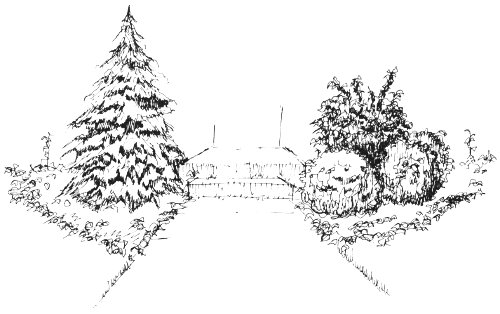
A single small upright Juniper can be used to accent an entry.

Another accent area for your landscape may be located in your shrub border. This area could be to the rear of your property, where it can be viewed from the patio or living room window. Never place accent plants randomly through the shrub border. This causes each accent plant to “fight” for dominance.
Shrubs that will soften the lines of the house or buildings have a round, oval, or irregular shape. These shrubs break the strong vertical lines at the corners of the house, rather than call attention to them.
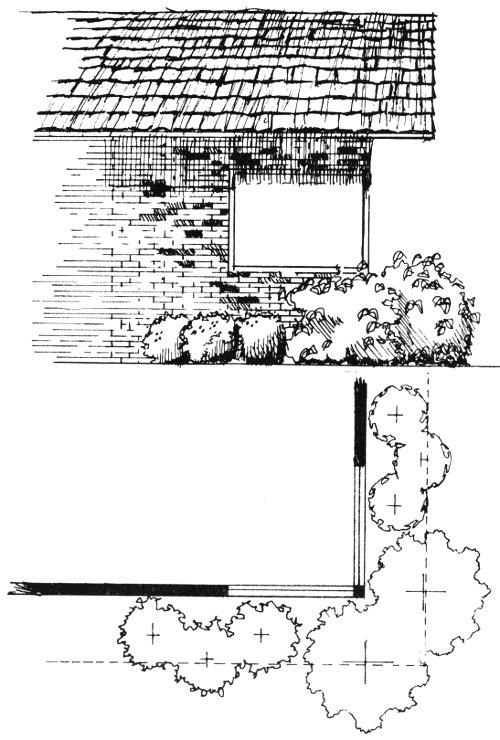
Shrubs will soften the lines at the corners of your house. Where windows are close to the corner, select dwarf shrubs that will not grow higher than the sill.
Never select shrubs that create an accent for corner plantings. Consider a brightly colored foliage on shrubs during the summer or fall as an accent. Do not plant upright-growing pyramidal evergreens, such as Junipers, for planting at the corners of your 5 home. The shape of these plants creates an accent which will detract from the foundation planting. Instead of softening the harsh vertical lines at the corners of the house, pyramidal-shaped shrubs call attention to them.

Use small ornamental trees to add a softer appearance to wall corners. Place these trees far enough away from the house that the branches will not rub against it when the tree is fully grown. Place low facer plants in front of the taller shrubs to give the corner planting more depth.
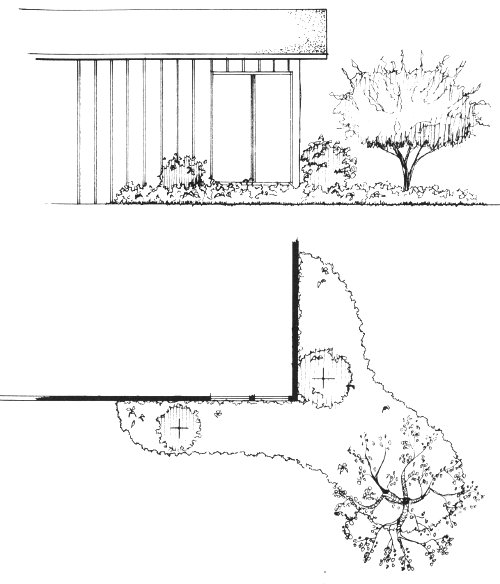
Floor length windows at the corners require low groundcovers or very dwarf shrubs below them. A small ornamental tree will assist in softening the corner, if you want some shade on the window. Extending the groundcover around the tree will make the mowing much easier.
Plants used as a transition are simply those shrubs or ground covers that pull together the plantings at the corners or accented entryways. These shrubs are used to soften the lines of the house, where the walls meet the ground.
Use shrubs that will not call attention to themselves by having bright foliage or coarse leaf texture. These shrubs also help to hide any exposed foundation walls along the house. Transition shrubs should be low-growing or dwarf in size. If the siding of your house extends to the ground without leaving the foundation walls exposed, a groundcover may be all that is required to add depth to the foundation planting.

Shrubs help hide unsightly construction
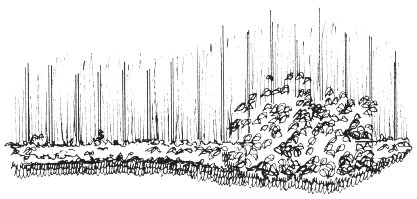

... and soften harsh house lines.

Whether you are selecting shrubs for the foundation plantings around the house or for a shrub border in your yard, choose shrubs that will bloom at different seasons. Most of the flowering shrubs that are available bloom during the spring. Once some shrubs have finished blooming, they have no other ornamental features. The interest in your landscape will be lost, unless you have selected some summer-blooming shrubs. Attempt to design your landscape so you can have continuous shrub bloom from early spring through late summer.

Most of the plants that are adapted for western Kansas will grow on the north side if they are planted 3 to 4 feet from the building and out from the roof overhang. In eastern Kansas it is necessary to consider shade tolerance when planting on the north side of the house.
Most shrubs will bloom more profusely and produce more fruit when planted in the sun, even though they may survive quite well in deep shade. Often shrubs will grow better in shade simply because they are protected from the southwest winds. If you don’t want to plant dwarf shrubs 3 to 4 feet out from the foundation of the house, then plant only shade tolerant shrubs.
What is often thought of as a shade problem is often the result of competition from the roots of adjoining trees. Apply plant food and water and thin the tree branches to correct this problem.
The shrubs listed for shady locations may be expected to perform adequately on the north side of the house or behind fences in deep shade. Many of these same shrubs will do equally well in strong sunlight or shade.
Consider low maintenance when planning your landscape. When selecting shrubs for your yard, determine the maximum height and spread you want from the planting, and then select only from shrubs with those characteristics.
The shrubs listed in this bulletin have been grouped according to their mature heights. If you are looking for a shrub that will grow under a window that is 4 feet from the ground, select from those listed as dwarf shrubs. You certainly would not select a Tatarian Honeysuckle (10 to 12 feet) for this location.
Never select a shrub that will ultimately grow too high for its location and expect to keep it shorter by constant clipping. This will only add to your time in maintaining your landscape.

Wrong selection of shrubs can be disastrous as shown by the planting on the right.
Shrubs will require periodic pruning to maintain their proper shape and size. Many shrubs will grow tall and spindly if not thinned-out occasionally. Some shrubs will sucker severely at the ground if the older stems or canes are not removed. This causes the shrub to spread beyond its normal limits.
The proper method for maintaining shrub shape is to remove all canes that are larger than one inch in diameter. These should be removed as close to the ground line as possible. This practice will open the center of the plant so that more light can penetrate into it. Also, the size of the shrub will be maintained at the desirable height.
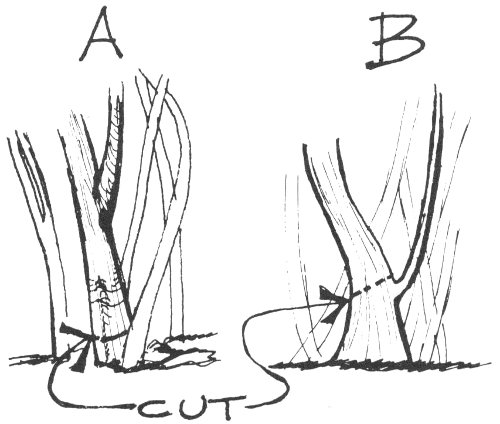
When removal of a cane has been decided upon, make the cut as close to the ground as possible (example A). When an old cane selected for removal has a desirable shoot at its base, make a cut as shown in example B. Note that the cut is slanted and is approximately ¼ inch above the shoot.
Which plants are best suited for your landscape? This will depend on whether the shrubs will be planted on a farmstead or in a city lot. It will also depend on whether your yard is exposed to direct southwest winds, or whether you have some protection.
Plant adaptability has been considered for each shrub listed in this bulletin. You may plant any shrub that is listed as ‘Hardy’ in an open, fully exposed location and expect it to survive. Those shrubs that have an ‘X’ will most likely not survive if planted where they will receive direct exposure to the hot winds of late summer. If you live in a town or city, you 11 may have enough wind protection to use these shrubs. This is most important for homeowners living in the western counties of Kansas.
Protection from southwest summer winds may be provided by a windbreak, trees in the city, by planting on the east or north side of the house, or behind a screen fence. If you have this protection you might be able to use plants that are not listed for your area. However, if your yard is exposed to hot summer winds, you had better use only the plant listed for your section of Kansas.
You will sometimes find plants growing in your area that are not listed for your particular section of Kansas. It is possible to grow some plants outside their recommended region, provided these plants receive adequate protection and care. These shrubs will usually not grow as large or as tall as they would further south or east. If you are rather certain that your yard will provide enough protection for these plants, you might try growing a few.

| Common Name | Botanical Name | Height | Spread | Adaptability[1] | |
|---|---|---|---|---|---|
| DECIDUOUS SHRUBS: Tall (10 feet in height or more) | |||||
| Cotoneaster, Peking | Cotoneaster acutifolia | 10-12′ | 8-10′ | Hardy | |
| Cranberrybush, American | Viburnum trilobum | 12′ | 10-12′ | Hardy | |
| Cranberrybush, European | Viburnum opulus | 8-12′ | 10-12′ | Hardy | |
| Crapemyrtle | Lagerstroemia indica | 10-12′ | 5′ | SE | |
| Dogwood, Gray | Cornus racemosa | 8-12′ | 8-12′ | Hardy | |
| Elder, Golden | Sambucus canadensis ′Aurea’ | 12′ | 10-12′ | Hardy | |
| Fringe Tree, Red | Cotonis coggygria ′rubrifolia’ | 10′ | 10-12′ | X, P | |
| Honeysuckle, Tatarian | Lonicera tatarica | 10-12′ | 8-10′ | Hardy | |
| Hydrangea, P. G. | Hydrangea paniculata ′grandiflora’ | 10-15′ | 10-15′ | X, P | |
| Lilac, Chinese (Rothamagensis) | Syringa chinensis | 10-15′ | 10-15′ | Hardy | |
| Lilac, Common | Syringa vulgaris | 12-15′ | 12-15′ | Hardy | |
| Lilac, Manchurian | Syringa amurensis | 12-15′ | 12-15′ | Hardy | |
| Lilac, Peking | Syringa pekinensis | 10-15′ | 10-15′ | Hardy | |
| Maple, Amur | Acer ginneis | 15-20′ | 10-12′ | X, P | |
| Mockorange, Big Scentless | Philadelphus grandiflorus | 9-12′ | 5-8′ | Hardy | |
| Olive, Autumn | Eleagnus umbellatus | 14-16′ | 15-17′ | Hardy | |
| Pea Shrub | Caragana arborescens | 15-18′ | 12-15′ | Hardy | |
| Pearlbush | Exochorda racemosa | 10-15′ | 10-15′ | SC | |
| Plum, Flowering | Prunus triloba ′plena’ | 12′ | 10-12′ | X | |
| Privit, Amur River North | Ligustrum amurense | 10-12′ | 5-7′ | Hardy | |
| Privit, California | Ligustrum ovalifolium | 10-12′ | 6-8′ | X, P | |
| Privit, Common | Ligustrum vulgare | 10-12′ | 6-8′ | Hardy | |
| Privit, Golden (Vicary) | Ligustrum X vicari | 12′ | 6-8′ | X, P | |
| Redbud, Chinese | Cercis chinensis | 10-12′ | 10-12′ | X, P | |
| Rose-of-Sharon (Althea) | Hibiscus syriacus | 8-12′ | 6-10′ | Hardy | |
| Smoke Tree (Purple Fringe) | Cotinus coggygria | 15′ | 8′ | X, P | |
| Snowball | Viburnum opulus ′sterilis’ | 8-12′ | 10-12′ | Hardy | |
| Sumac, Smooth | Rhus giabra | 10-12′ | 12′ | Hardy | |
| Sumac, Staghorn | Rhus typhina | 20′ | 15-20′ | Hardy | |
| Tamarisk, Common | Tamarix hispida | 10-12′ | 8-10′ | Hardy | |
| Tamarisk, African | Tamarix africana | 10-12 | 10′ | SE | |
| Viburnum, Arrowwood | Viburnum dentatum | 8-10′ | 10-12′ | NC, P | |
| Viburnum, Nannyberry | Viburnum lentago | 8-12′ | 10-12′ | Hardy | |
| Viburnum, Siebold | Viburnum sieboldi | 12-15′ | 10-12′ | NC | |
| Viburnum, Tea | Viburnum setigerum | 10′ | 8-10′ | NC | |
| Wahoo | Euonymus atropurpureus | 10-15′ | 15-18′ | Hardy | |
| Wayfaring Tree | Viburnum lantana | 10-12′ | 12′ | NC | |
| Willow, Corkscrew | Salix matsudana ‘tortuosa’ | 12-15′ | 12′ | X, P | |
| Willow, Pussy | Salix discolor | 10-12′ | 12′ | X, P | |
| DECIDUOUS SHRUBS: Medium (between 7 and 10 feet in height) | |||||
| Barberry, Mentor | Berberis mentorensis | 6-8′ | 5-7′ | Hardy | |
| Barberry, Truehedge | Berberis thunbergi ‘erecta’ | 6-8′ | 4-6′ | X, P | |
| Bayberry, Northern | Myrica pennsylvanica | 6-8′ | 4-6′ | Hardy | |
| Beautybush | Kolkwitzia amabilis | 7-10′ | 8-10′ | Hardy | |
| Burning Bush, Winged | Euonymus alatus | 8-10′ | 8-10′ | X, P | |
| Butterfly Bush | Buddleia davidi | 6-8′ | 6′ | NC | |
| Cherry, Nanking | Prunus tomentosa ‘Orient’ | 9′ | 10-12′ | Hardy | |
| Cotoneaster, Large Flowering | Cotoneaster multiflora | 8′ | 8-12′ | Hardy | |
| Crabapple, Sargent | Malus sargentii | 6-8′ | 8-10′ | Hardy | |
| Deutzia, Lemoine | Deutzia X lemoinei | 5-7′ | 5-7′ | NC, P | |
| Deutzia, ‘Pride of Rochester’ | Deutzia scabra | 6-8′ | 4-6′ | NC, P | |
| Dogwood, Coral | Cornus alba ‘Siberica’ | 9′ | 8-10′ | NC | |
| Dogwood, Redosier | Cornus stolonifera | 8′ | 8-10′ | X, P | |
| Dogwood, Silky | Cornus ammomum | 8-10′ | 8-10′ | X, P | |
| Dogwood, Yellowtwig | Cornus stolonifera ‘flaviramea’ | 8′ | 8-10′ | X, P | |
| Forsythia, Beatrix Farrand | Forsythia x intermedia | 6-8′ | 6-8′ | X, P | |
| Forsythia, Golden Bell | Forsythia viridissima | 6-8′ | 5-6′ | X, P | |
| Forsythia, ‘Karl Sax’ | Forsythia X intermedia | 6-8′ | 6-8′ | X, P | |
| Forsythia, ‘Lynwood Gold’ | Forsythia X intermedia | 8-10′ | 8′ | X, P | |
| Forsythia, ‘Showy Border’ | Forsythia X intermedia | 7-8′ | 6-8′ | X, P | |
| Forsythia, ‘Siebold’ | Forsythia suspensa ‘Sieboldii’ | 8-10′ | 10-15′ | Hardy | |
| Forsythia, ‘Spring Glory’ | Forsythia X intermedia | 7-8′ | 6-8′ | X, P | |
| Holly, Winterberry | Ilex verticillata | 6-8′ | 3-5′ | NC, P | |
| Honeysuckle, Morrow | Lonicera morrowi | 6-8′ | 8-10′ | Hardy | |
| Honeysuckle, Zabel | Lonicera tatarica ‘Zabelii’ | 7-10′ | 7-10′ | Hardy | |
| Jetbead, Black | Rhodotypos scandens | 5-7′ | 6-8′ | NC, P | |
| Lilac, Late | Syringa villosa | 8-10′ | 8-10′ | Hardy | |
| Lilac, Persian | Syringa X persica | 6-8′ | 7-9′ | NC | |
| Magnolia, Star | Magnolia stellata | 8-12′ | 10-12′ | SC, P | |
| Mockorange, ‘Enchantment’ | Philadelphus X lemoine | 8′ | 6-8′ | Hardy | |
| Mockorange, ‘Innocence’ | Philadelphus X lemoine | 8′ | 6-8′ | Hardy | |
| Mockorange, ‘Minnesota Snowflake’ | Philadelphus X virginalis | 8′ | 6-8′ | Hardy | |
| Mockorange, Sweet | Philadelphus coronarius | 8-10′ | 6-7′ | Hardy | |
| Ninebark, Common | Physocarpus opulifolius | 7-9′ | 8-10′ | Hardy | |
| Ninebark, ‘Goldleaf’ | Physocarpus opulifolius ‘luteus’ | 8-10′ | 8-10′ | Hardy | |
| Privit, Border | Ligustrum obtusifolium | 8-10′ | 9′ | X, P | |
| Privit, Regel | Ligustrum obtusifolium ‘regelium’ | 5-7′ | 6′ | Hardy | |
| Sand Cherry, Purpleleaf | Prunus X cistena | 7-9′ | 8-10′ | Hardy | |
| Scotch Broom | Cytisus scoparius | 6-8′ | 6-8′ | SC | |
| Spirea, Bridalwreath | Spirea prunifolia ‘plena’ | 7-9′ | 8-10′ | NC, P | |
| Spirea, Vanhoutte | Spirea X vanhouttei | 6-8′ | 8-10′ | Hardy | |
| Tamarisk, ‘Summer Glow’ | Tamarix hispida | 8′ | 10-12′ | Hardy | |
| Viburnum, Doublefile | Viburnum plicatum ‘tomentosum’ | 8-10′ | 8-10′ | NC, P | |
| Viburnum, Korean Spice | Viburnum carlesii | 6-8′ | 6-8′ | Hardy | |
| Viburnum, Linden | Viburnum dilatatum | 8-10′ | 8-12′ | NC, P | |
| Weigela, Old Fashioned | Weigela florida | 6-8′ | 8-10′ | X, P | |
| DECIDUOUS SHRUBS: Small (between 4 and 6 feet in height) | |||||
| Abelia, Glossy | Abelia X grandiflora | 3-5′ | 3-5′ | SC, P | |
| Almond, Flowering (Cherry) | Prunus glandulosa | 4-5′ | 3-4′ | Hardy | |
| Barberry, Japanese (Green) | Berberis thunbergii | 4-6′ | 3-5′ | X, P | |
| Barberry, Redleaf | Berberis thunbergii ‘atropurpurea’ | 4-5′ | 3-5′ | X, P | |
| Barberry, Kobold | Berberis thunbergii ‘Kobold’ | 4-6′ | 5-6′ | X, P | |
| Beautyberry, Japanese | Callicarpa japonica | 4-5′ | 4-5′ | NC, P | |
| Burning Bush, Dwarf Winged | Euonymus alatus ‘compacta’ | 4-5′ | 4-5′ | X, P | |
| Cotoneaster, Spreading | Cotoneaster divaricata | 5-6′ | 6-8′ | X, P | |
| Cranberry, Compact European | Viburnum opulus ‘compactum’ | 4-6′ | 4-6′ | Hardy | |
| Honeysuckle, Clavey’s Dwarf | Lonicera xylosteum | 4-6′ | 4-6′ | Hardy | |
| Honeysuckle, Winter (Fragrant) | Lonicera fragrantissima | 5-7′ | 6′ | Hardy | |
| Hydrangea, A. G. | Hydrangea arborescens ‘grandiflora’ | 3-5′ | 5-7′ | NC, P | |
| Hydrangea, ‘Nikko Blue’ | Hydrangea macrophylla | 4-5′ | 5-6′ | X, P | |
| Indian-current Coralberry | Symphoricarpos orbiculatus | 3-5′ | 4-5′ | Hardy | |
| Kerria | Kerria japonica | 4-6′ | 5-7′ | X, P | |
| Lilac, Dwarf Korean | Syringa oblata ‘palibiniana’ | 4-6′ | 6-8′ | NC, P | |
| Mockorange, ‘Albatre’ | Philadelphus X virginalis | 4-6′ | 4-6′ | Hardy | |
| Mockorange, ‘Belle Etoille’ | Philadelphus X lemoine | 6′ | 6′ | Hardy | |
| Mockorange, ‘Bouquet Blanc’ | Philadelphus X virginalis | 6′ | 6′ | Hardy | |
| Mockorange, ‘Glacier’ | Philadelphus X virginalis | 4-6′ | 4-6′ | Hardy | |
| Quince, Japanese Flowering | Chaenomeles lagenaria (speciosa) | 5-7′ | 6-8′ | X, P | |
| Snowberry | Symphoricarpos albus | 4-6′ | 4-6′ | Hardy | |
| Spirea, Garland | Spirea X arguta | 5-6′ | 5-6′ | X, P | |
| Spirea, Thunberg | Spirea thunbergi | 4-5′ | 4-5′ | Hardy | |
| Viburnum, Wright’s | Viburnum wrighti ‘hessei’ | 3-5′ | 4-6′ | X, P | |
| Weigela, ‘Bristol Ruby’ | Weigela X florida | 4-6′ | 4-6′ | X, P | |
| Weigela, ‘Eva Rathke’ | Weigela X floribunda | 4-6′ | 6-8′ | X, P | |
| Weigela, ‘Java Red’ | Weigela purpurea | 5-7′ | 6-8′ | X, P | |
| DECIDUOUS SHRUBS: Dwarf (less than 4 feet in height) | |||||
| Barberry, Crimson Pygmy | Berberis thunbergi ‘nana’ | 1½-2′ | 2-3′ | X, P | |
| Chenauit Coralberry | Symphoricarpos X chenauiti | 3-4′ | 3-4′ | Hardy | |
| Cinquefoil | Potentilla fruticosa | 2-4′ | 2-4′ | Hardy | |
| Cotoneaster, Cranberry | Cotoneaster apiculata | 2-3′ | 3-4′ | X, P | |
| Deutzia, Rosepanicle | Deutzia X rosea ‘eximia’ | 3-4′ | 4-5′ | NC | |
| Deutzia, Slender | Deutzia gracilis | 2-3′ | 3-4′ | NC | |
| Forsythia, ‘Bronx’ | Forsythia viridissima ‘Bronxensis’ | 1½-2′ | 3′ | X, P | |
| Hydrangea, ‘Annabelle’ | Hydrangea X arborescens | 3-4′ | 4-5′ | X, P | |
| Mockorange, Silver Showers | Philadelphus X lemoine | 3-4′ | 3-4′ | Hardy | |
| Mockorange, ‘Dwarf Minnesota Snowflake’ | Philadelphus X virginalis ‘nana’ | 2-3′ | 2-3′ | Hardy | |
| Mockorange, Dwarf Sweet | Philadelphus coronarius ‘nana’ | 3-4′ | 3-4′ | Hardy | |
| Ninebark, Dwarf | Physocarpus opulitolius ‘nanus’ | 3-4′ | 3-4′ | Hardy | |
| Pea Shrub, Pygmy | Caragana arborescens | 1½-2′ | 1½-2′ | Hardy | |
| Quince, Dwarf Flowering | Chaenomeles meulei | 2-3′ | 2-3′ | X, P | |
| Quince, Japanese Flowering | Chaenomeles japonica | 3-4′ | 4-5′ | Hardy | |
| Quince, Red Japanese | Chaenomeles japonica ‘rubra’ | 3-4′ | 4-5′ | Hardy | |
| St. Johnswort, Hidcote | Hypericum patulum ‘Hidcote’ | 1½-2′ | 1½-2′ | X | |
| St. Johnswort, Kalm | Hypericum kalmianum | 3-4′ | 3-4′ | Hardy | |
| St. Johnswort, Sungold | Hypericum patulum ‘Sungold’ | 1½-2′ | 1½-2′ | Hardy | |
| Spirea, Anthony Waterer | Spirea X bumalda ‘Anthony Waterer’ | 2-3′ | 2-3′ | X, P | |
| Spirea, Froebel | Spirea X bumalda ‘Froebeli’ | 3-4′ | 3-4′ | X, P | |
| Spirea, Redflowering | Spirea japonica ‘coccinea’ | 3-4′ | 3-4′ | X, P | |
| Spirea, Snowmound | Spirea nipponica ‘Snowmound’ | 3-4′ | 3-4′ | Hardy | |
| Willow, Dwarf Arctic Blue | Salix purpurea ‘nana’ | 3-4′ | 3-4′ | NC | |
| Common Name | Botanical Name | Height | Spread | Adaptability[1] | |
|---|---|---|---|---|---|
| BROADLEAF EVERGREEN SHRUBS: Tall (10 feet or more in height) | |||||
| Holly, American | Ilex opaca | 12-15′ | 8-10′ | SC, P | |
| Holly, Yaupon | Ilex vomitoria | 10-15′ | 8-10′ | SC, P | |
| Magnolia, Southern | Magnolia grandiflora | 15-20′ | 10-12′ | SC, P | |
| BROADLEAF EVERGREEN SHRUBS: Medium (between 7 and 10 feet in height) | |||||
| Euonymus, Large-Leaf | Euonymus kiautschovicus (Patens) | 6-8′ | 8-10′ | Hardy | |
| Euonymus, ‘Manhattan’ | Euonymus kiautschovicus (Patens) | 8-10′ | 8-12′ | Hardy | |
| Mahonia, Oregon Grape | Mahonia aquifolium | 5-7′ | 4-5′ | Hardy | |
| Pyracantha, ‘Kasan’ | Pyracantha coccinea ‘Kasan’ | 6-8′ | 6-8′ | X, P | |
| Pyracantha, ‘Lalandii’ | Pyracantha coccinea ‘Lalandii’ | 5-10′ | 8-10′ | X, P | |
| Pyracantha, ‘Wyatti’ | Pyracantha coccinea ‘Wyatti’ | 6-8′ | 6-8′ | X, P | |
| Viburnum, Leatherleaf | Viburnum rhytidophylium | 8-12′ | 8-12′ | NC, P | |
| BROADLEAF EVERGREEN SHRUBS: Small (between 4 and 6 feet in height) | |||||
| Barberry, Wintergreen | Berbaris juliana | 4-6′ | 3-5′ | NC, P | |
| Euonymus, Dupont | Euonymus kiautschovicus (Patens) | 5-6′ | 4-6′ | Hardy | |
| Euonymus, ‘Emerald ’n’ Gold’ | Euonymus fortunei ‘vegetus’ | 4-5′ | 4′ | X, P | |
| Euonymus, ‘Jewel’ | Euonymus kiautschovicus (Patens) | 5-6′ | 4-6′ | Hardy | |
| Euonymus, Medium Leaf | Euonymus kiautschovicus (Patens) | 5-6′ | 4-6′ | Hardy | |
| Euonymus, ‘Sarcoxie’ | Euonymus fortunei ‘vegetus’ | 4-5′ | 4′ | X, P | |
| Holly, Dwarf Japanese | Ilex crenata ‘compacta’ | 4-5′ | 4-5′ | SC, P | |
| Holly, ‘Hellers’ Japanese | Ilex crenata ‘Helleri’ | 4′ | 5′ | SC, P | |
| Holly, Hetz Japanese | Ilex crenata ‘Hetzii’ | 4′ | 5′ | SC, P | |
| Holly, Dwarf Yaupon | Ilex vomitoria ‘nana’ | 4′ | 5′ | SC, P | |
| Nandina | Nandina domestica | 4-5′ | 4′ | SC, P | |
| Pyracantha, ‘Low Boy’ | Pyracantha coccinea ‘Low Boy’ | 4-5′ | 4-5′ | X, P | |
| BROADLEAF EVERGREEN SHRUBS: Dwarf (less than 4 feet in height) | |||||
| Azalea, Kurume | Rhododendron obtusum | 3′ | 2-3′ | SC, P | |
| Azalea, Mollis Hybrid | Rhododendron X kosterianum | 3-4′ | 3-4′ | SC, P | |
| Boxwood, Edging | Buxus sempervirens | 2-3′ | 2-3′ | NC, P | |
| Boxwood, Wintergreen | Buxus microphylus | 4′ | 5′ | NC, P | |
| Euonymus, ‘Emerald Cushion’ | Euonymus fortunei ‘vegetus’ | 3-4′ | 3-4′ | X, P | |
| Euonymus, ‘Emerald Gaiety’ | Euonymus fortunei ‘vegetus’ | 3-4′ | 2-3′ | X, P | |
| Euonymus, Small Leaf | Euonymus kiautschovicus (Patens) | 2-3′ | 2-3′ | Hardy | |
| Euonymus, Vinca Leaf | Euonymus kiautschovicus ‘vincafolia’ | 3-4′ | 3-4′ | X, P | |
| Holly, Dwarf Burford | Ilex cornuta ‘Burfordi nana’ | 3-4′ | 2-3′ | Hardy | |
| Rhododendron | Rhododendron catawbiense | 4′ | 4′ | SC, P | |
Every shrub species grown in Kansas can be expected to be afflicted with some problem during its lifetime. The most common problems are insect and disease attacks. These usually can be controlled by routine spraying. Knowledge of the problems make it easier to diagnose and correct before they become severe.
Soil alkalinity or high pH may also limit the use of some plants. Iron chlorosis is a common problem with some shrubs grown in the western half of Kansas. This is easily corrected by applying iron sulfate or iron chelate to the plant or soil.
Your local County Extension Agent can assist you with the diagnosis of any disease, insect, or cultural problem.

All Kansas Extension educational programs and materials are available to all individuals without discrimination on the basis of race, color, national origin, sex, or religion.
Cooperative Extension Service, Kansas State University, Manhattan
C-469 February 1973
Issued in furtherance of Cooperative Extension work, acts of May 8 and June 30, 1914, in cooperation with U. S. Department of Agriculture. Robert A. Bohannon, Director of Extension, Kansas State University of Agriculture and Applied Science.
34-6672 2-73—20M
KANSAS STATE PRINTING PLANT